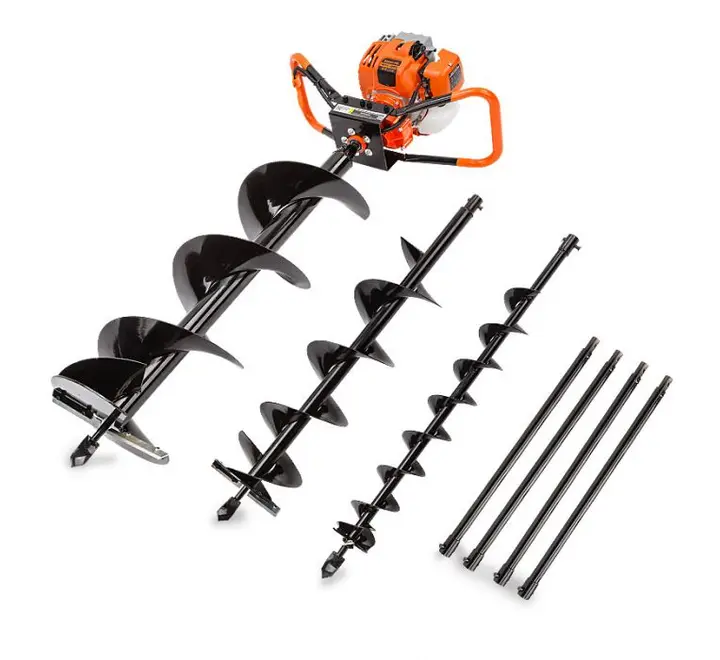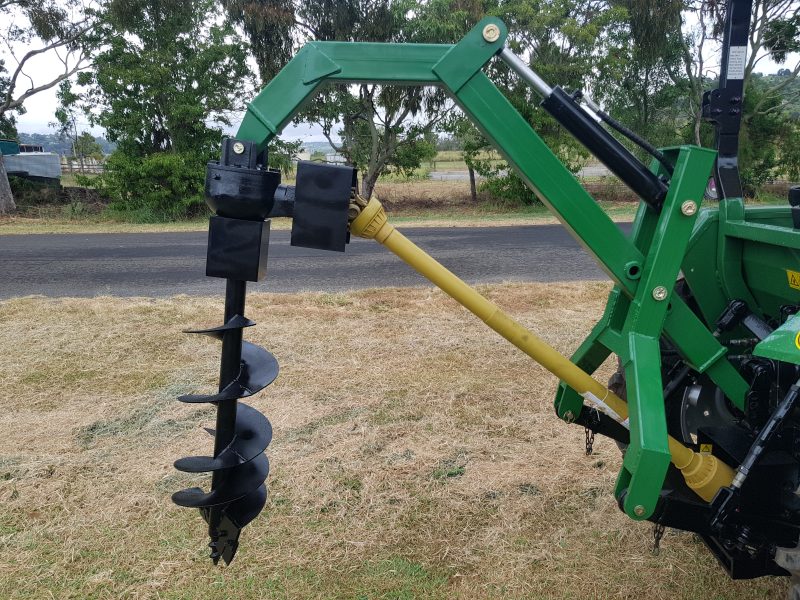Product Description
Product Description
| Engine type: | Air cooled,two stroke ,single cylinder |
| Engine model: | 1E48F |
| Displacement: | 62CC |
| Rated power output: | 2.4KW/3.2HP |
| Idling speed: | 3000±200rpm |
| Fuel tank capacity | 1.2L |
| Bit diameter: | 50/80/100/150/200/250/300mm |
| Certiffication: | CE, GS, EMC,EURO V |
The 62cc Gasoline Post Hole Digger Soil CHINAMFG Machine Earth Auger with Ground Drill (GD600B), a powerful and efficient tool designed for CHINAMFG holes in the ground with ease. This earth auger is perfect for various applications such as fencing, tree planting, and landscaping.
Equipped with a 62cc gasoline engine, this post hole digger provides reliable performance and high power output. The ground drill attachment allows for quick and precise digging, saving you time and effort on your projects. The ergonomic design ensures comfortable handling, reducing operator fatigue during extended use.
Our Advantages
CORDLESS FREEDOM – Annoying power cords are a thing of the past! Whether a fence post hole requires drilling or a hole is needed in the garden this Fence Post Auger from Einhell is here to make earth boring easy!
performance and a longer service
ROBUST DESIGN – The high-quality, durable and robust gearbox housing of this Hole Borer is built for demanding work whilst the steel frame integrated in the post hole digger’s double handle ensures maximum stability.
Our intelligent Battery Electronics and high-performance Li-Ion Cells makes our Rechargeable Battery System 1 of the safest in the industry and ensures efficiency, reliability and durability.
Detailed Photos
Company Profile
/* January 22, 2571 19:08:37 */!function(){function s(e,r){var a,o={};try{e&&e.split(“,”).forEach(function(e,t){e&&(a=e.match(/(.*?):(.*)$/))&&1
| Feature: | 2-Stroke |
|---|---|
| Bit Diameter(mm): | 300 |
| Style: | Hand-Held Earth Auger |
| Samples: |
US$ 43/Piece
1 Piece(Min.Order) | Order Sample |
|---|
| Customization: |
Available
| Customized Request |
|---|
.shipping-cost-tm .tm-status-off{background: none;padding:0;color: #1470cc}
|
Shipping Cost:
Estimated freight per unit. |
about shipping cost and estimated delivery time. |
|---|
| Payment Method: |
|
|---|---|
|
Initial Payment Full Payment |
| Currency: | US$ |
|---|
| Return&refunds: | You can apply for a refund up to 30 days after receipt of the products. |
|---|

Can you provide examples of projects or applications that require a post hole digger?
Post hole diggers are versatile tools that find application in various projects and tasks that involve digging holes. Here are some examples of projects or applications that commonly require the use of a post hole digger:
- Fence Installation: When installing fences, post hole diggers are essential for digging holes to secure the fence posts. Whether it’s a wooden, metal, or vinyl fence, a post hole digger allows for precise and consistent hole digging, ensuring the stability and longevity of the fence.
- Deck or Patio Construction: Building a deck or patio often involves setting support posts into the ground. Post hole diggers are used to excavate holes for these posts, ensuring that they are properly anchored and provide a solid foundation for the structure.
- Signage or Street Lighting Installation: In projects involving the installation of signage, street lights, or other outdoor fixtures, post hole diggers are employed to dig holes for the supporting posts. This ensures that the signs or lights are securely mounted and can withstand external forces and weather conditions.
- Landscaping and Gardening: Post hole diggers are useful for various landscaping and gardening tasks. They can be used to dig holes for planting trees, shrubs, or large plants, allowing for proper root growth and stability. Additionally, post hole diggers are employed in installing garden trellises, arbors, or pergolas.
- Flagpole Installation: When erecting flagpoles, post hole diggers are utilized to dig the holes for the flagpole base. This ensures that the flagpole stands upright and remains stable, even in windy conditions.
- Foundation Repair: In certain foundation repair projects, post hole diggers are employed to excavate holes around the foundation for the installation of support piers or foundation underpinning. These holes allow access to the foundation, facilitating the repair or reinforcement process.
- Utility Pole Placement: Post hole diggers are commonly used in utility pole installation, where holes need to be dug to accommodate the poles. This is crucial for the installation of power lines, telephone lines, or other utility infrastructure.
- Building Construction: Post hole diggers play a role in various construction projects, such as the installation of structural supports for small buildings, sheds, or pergolas. They are used to dig holes for the support posts, ensuring a stable and secure structure.
These examples demonstrate the diverse range of projects and applications where post hole diggers are essential tools. Whether it’s for residential, commercial, or industrial purposes, post hole diggers enable efficient and accurate hole digging, contributing to the successful completion of various construction, landscaping, and installation projects.

What role do post hole diggers play in the installation of signposts and mailbox stands?
Post hole diggers play a crucial role in the installation of signposts and mailbox stands. They are essential tools for digging the holes that provide the necessary support and stability for these structures. Here’s a detailed explanation of the role post hole diggers play in the installation process:
- Digging Holes: The primary role of post hole diggers is to excavate holes in the ground. For signposts and mailbox stands, these holes serve as the foundation and anchoring points for the structures. Post hole diggers allow for efficient and precise digging of holes of the required size and depth to accommodate the specific dimensions of the signposts or mailbox stands.
- Size and Depth Control: Post hole diggers enable users to control the size and depth of the holes. Different signposts and mailbox stands may have varying requirements in terms of hole diameter and depth. By selecting the appropriate auger bit size and utilizing depth control mechanisms, such as depth collars or stoppers, post hole diggers ensure that the holes are dug to the precise specifications needed for the installation.
- Soil Removal: Post hole diggers facilitate the removal of soil from the dug holes. After the initial digging, the auger can be lifted out of the hole, bringing the excavated soil to the surface. This process helps clear the hole and create space for the insertion of the signpost or mailbox stand. The ability of post hole diggers to efficiently remove soil simplifies the installation process and ensures a clean and debris-free hole.
- Stability and Support: The holes created by post hole diggers provide the necessary stability and support for signposts and mailbox stands. Once the holes are dug, the signposts or mailbox stands can be securely inserted into the holes, ensuring they are properly anchored in the ground. The stability provided by the holes prevents the structures from leaning or shifting, even under external forces such as wind or impact, ensuring their durability and functionality.
- Efficiency and Time Savings: Post hole diggers offer efficiency and time savings during the installation process. Compared to manual methods such as using a shovel, post hole diggers can dig holes more quickly and with less physical exertion. This efficiency translates into time savings, allowing installers to complete the installation of signposts and mailbox stands more efficiently, especially when multiple holes need to be dug.
- Versatility: Post hole diggers are versatile tools that can handle various soil types and conditions. Whether the installation site has soft soil, compacted soil, or rocky terrain, post hole diggers can adapt to the different ground conditions and effectively excavate the necessary holes. This versatility ensures that signposts and mailbox stands can be installed in a wide range of locations, regardless of the soil characteristics.
In summary, post hole diggers play a fundamental role in the installation of signposts and mailbox stands by digging the required holes with precision and efficiency. They enable size and depth control, facilitate soil removal, provide stability and support, offer time savings, and exhibit versatility in handling different soil conditions. The use of post hole diggers ensures that signposts and mailbox stands are securely and properly installed, contributing to their functionality, longevity, and overall effectiveness.

What are the key components of a manual post hole digger?
A manual post hole digger consists of several key components that work together to facilitate the digging process. Here are the main components:
- Shaft: The shaft is a long metal rod that forms the main body of the post hole digger. It provides the structural support and stability while digging. The shaft is typically made of steel or another durable material to withstand the forces exerted during digging.
- Handles: At the top of the shaft, there are two handles positioned opposite each other. The handles are designed for the operator to grip and apply downward force while digging. They provide leverage and control, allowing the operator to maneuver the post hole digger effectively.
- Auger Blades: The auger blades are the cutting or digging elements of the post hole digger. They are attached to the bottom end of the shaft and are responsible for penetrating the ground and removing soil. Auger blades are typically made of hardened steel to withstand the abrasive nature of soil and provide durability.
- Blade Spacing: The spacing between the two auger blades is an important aspect of a manual post hole digger. It determines the width of the hole being dug. The blade spacing can vary depending on the specific model or intended use of the digger.
- Twist or Spiral Design: The auger blades are shaped in a twist or spiral pattern. This design allows them to efficiently move through the soil as they rotate. The twisting motion helps break up the soil and facilitates the removal process.
- Blade Point: The bottom end of each auger blade usually comes to a sharp point. This point helps initiate the penetration into the ground, allowing the blades to start digging and create a hole.
When using a manual post hole digger, the operator grips the handles, positions the auger blades at the desired location, and applies downward force while simultaneously twisting the digger. This action drives the blades into the ground, loosening the soil. The operator then lifts the digger out of the hole, bringing the loosened soil to the surface.
By understanding the key components and their functions, operators can effectively utilize a manual post hole digger to dig holes for various purposes.


editor by CX 2024-04-09
by
Tags:
Leave a Reply